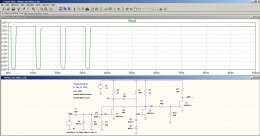Post by Bill SlomanPost by John LarkinOn Wed, 15 May 2024 22:46:27 -0000 (UTC), piglet
Post by pigletPost by John Larkinhttps://www.dropbox.com/scl/fi/agatzclr8pvr5470g6mc4/Phemt_One_Shot_1.jpg?rlkey=cwnx0qd7ajgnh8otf627x5lku&raw=1
Regular monostables are terribly slow. This one has low prop delay and
high rep-rate, if the sim is to be believed.
SAV541 is mostly specified as an RF part, but it's a dynamite switch.
I can post a link to the files if anybody wants to play with this. All
my values are first guesses, no math involved, and it works!
My SAV541 Spice model is a revision of Phil Hobbs' original.
Mini-Circuits is adamant that they will never provide Spice models, a
typical RF-bigot attitude.
Yay! Eccles-Jordan ride again.
1918!
I think that was a bistable. I don't know when the monostable was > invented.
https://en.wikipedia.org/wiki/Multivibrator
has a two quotes from 1942 one from 1943 and two from 1949 which make it
clear that monostable had been invented by then. It sees it as a cut
down bistable, so Eccles-Jordan is probably a good name.
Since the first multivibrator circuit, the astable multivibrator
oscillator, was invented by Henri Abraham and Eugene Bloch during World
War I, it probably isn't the right name.
https://apps.dtic.mil/sti/tr/pdf/AD0410225.pdf
is a 1963 Ph.D. on the bistable circuit.
Post by John LarkinPeople tend to roll eyes when I use one-shots in logic designs. I
can't see why.
You can't trigger a one-shot immediately after it has been triggered,
and the pulse width you get can be reduced if you re-trigger it too soon
after it has generated it's pulse, when it hasn't entirely recovered.
Using a properly terminated delay line to set the output pulse width
could reduce this uncertainty, but I've never done it.
Or rather when I did do it
Sloman, A.W. and Swords, M.D. "A fast and economical gated
discriminator", Journal of Physics E: Scientific Instruments, 11,
521-524 (1978).
I didn't do it to get a more stable delay but rather because I needed
narrower pulses than I could get out of any monostable I could buy at
the time. As the paper notes, the MC10198 could have delivered, but it
wasn't available when I was putting the circuit together.
One of the delay lines I used - 350 mm of 50R coaxial cable, or 1.6nsec
- would have been too short for even the MC10198 - but the rest (5nsec,
10nsec, 20nsec and 100nsec were lumped constant thick film hybrids)
could have been replaced.
Post by Bill SlomanGhiggino, K.P., Phillips, D., and Sloman, A.W. "Nanosecond pulse
stretcher",Journal of Physics E: Scientific Instruments, 12, 686-687 (1979).
just used two 5GHz wide-band transistors (BFT95) and was perfectly
horrible, but it did what Dave Phillips and Ken Ghiggino had wanted me
to give them, and Ken Ghiggino wrote it up rather badly, but I was able
to rework the short paper into a form that was publishable and looks
nice on Ken's CV.
The fact the laser pulses it was designed to detect arrived at a steady
20MHz meant that it's worst defect didn't matter.
The 5GHz BFT95 was pretty new when I used it, and I got told about it by
one of the microwave guys at EMI. The Sloman and Swords paper preceded
the time I could get that kind of advice.
The 2n918 I did use in the 1978 paper was only good for 600MHz.
--
Bill Sloman, Sydney
